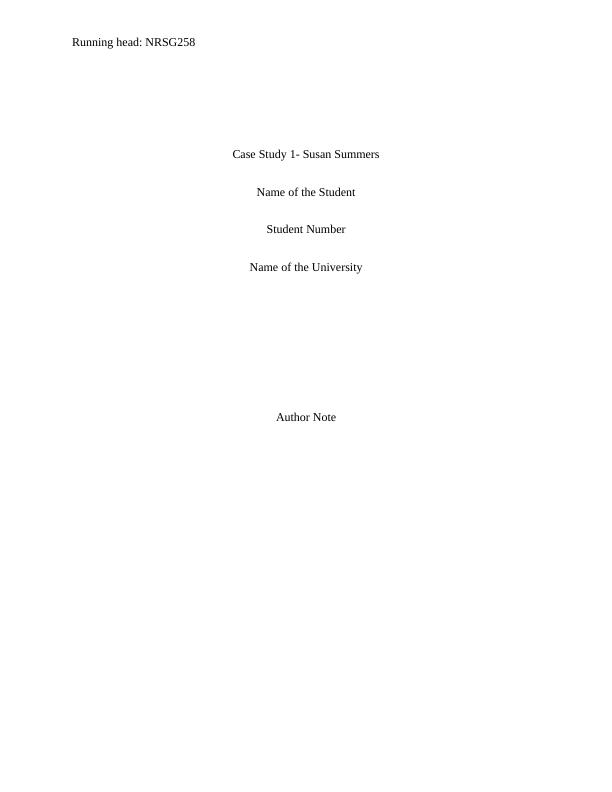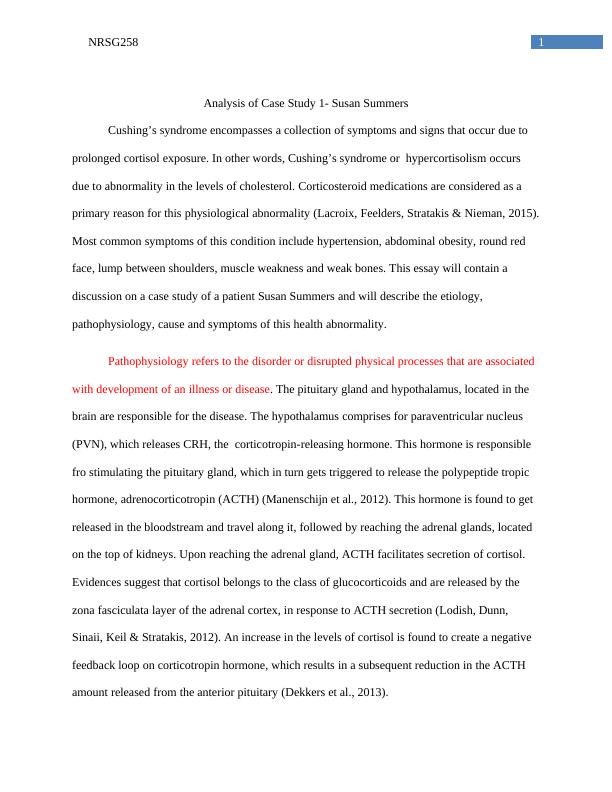NRSG258 Acute Care Nursing : Assignment
10 Pages2874 Words30 Views
Added on 2021-04-21
NRSG258 Acute Care Nursing : Assignment
Added on 2021-04-21
ShareRelated Documents
Running head: NRSG258
Case Study 1- Susan Summers
Name of the Student
Student Number
Name of the University
Author Note
Case Study 1- Susan Summers
Name of the Student
Student Number
Name of the University
Author Note

1NRSG258
Analysis of Case Study 1- Susan Summers
Cushing’s syndrome encompasses a collection of symptoms and signs that occur due to
prolonged cortisol exposure. In other words, Cushing’s syndrome or hypercortisolism occurs
due to abnormality in the levels of cholesterol. Corticosteroid medications are considered as a
primary reason for this physiological abnormality (Lacroix, Feelders, Stratakis & Nieman, 2015).
Most common symptoms of this condition include hypertension, abdominal obesity, round red
face, lump between shoulders, muscle weakness and weak bones. This essay will contain a
discussion on a case study of a patient Susan Summers and will describe the etiology,
pathophysiology, cause and symptoms of this health abnormality.
Pathophysiology refers to the disorder or disrupted physical processes that are associated
with development of an illness or disease. The pituitary gland and hypothalamus, located in the
brain are responsible for the disease. The hypothalamus comprises for paraventricular nucleus
(PVN), which releases CRH, the corticotropin-releasing hormone. This hormone is responsible
fro stimulating the pituitary gland, which in turn gets triggered to release the polypeptide tropic
hormone, adrenocorticotropin (ACTH) (Manenschijn et al., 2012). This hormone is found to get
released in the bloodstream and travel along it, followed by reaching the adrenal glands, located
on the top of kidneys. Upon reaching the adrenal gland, ACTH facilitates secretion of cortisol.
Evidences suggest that cortisol belongs to the class of glucocorticoids and are released by the
zona fasciculata layer of the adrenal cortex, in response to ACTH secretion (Lodish, Dunn,
Sinaii, Keil & Stratakis, 2012). An increase in the levels of cortisol is found to create a negative
feedback loop on corticotropin hormone, which results in a subsequent reduction in the ACTH
amount released from the anterior pituitary (Dekkers et al., 2013).
Analysis of Case Study 1- Susan Summers
Cushing’s syndrome encompasses a collection of symptoms and signs that occur due to
prolonged cortisol exposure. In other words, Cushing’s syndrome or hypercortisolism occurs
due to abnormality in the levels of cholesterol. Corticosteroid medications are considered as a
primary reason for this physiological abnormality (Lacroix, Feelders, Stratakis & Nieman, 2015).
Most common symptoms of this condition include hypertension, abdominal obesity, round red
face, lump between shoulders, muscle weakness and weak bones. This essay will contain a
discussion on a case study of a patient Susan Summers and will describe the etiology,
pathophysiology, cause and symptoms of this health abnormality.
Pathophysiology refers to the disorder or disrupted physical processes that are associated
with development of an illness or disease. The pituitary gland and hypothalamus, located in the
brain are responsible for the disease. The hypothalamus comprises for paraventricular nucleus
(PVN), which releases CRH, the corticotropin-releasing hormone. This hormone is responsible
fro stimulating the pituitary gland, which in turn gets triggered to release the polypeptide tropic
hormone, adrenocorticotropin (ACTH) (Manenschijn et al., 2012). This hormone is found to get
released in the bloodstream and travel along it, followed by reaching the adrenal glands, located
on the top of kidneys. Upon reaching the adrenal gland, ACTH facilitates secretion of cortisol.
Evidences suggest that cortisol belongs to the class of glucocorticoids and are released by the
zona fasciculata layer of the adrenal cortex, in response to ACTH secretion (Lodish, Dunn,
Sinaii, Keil & Stratakis, 2012). An increase in the levels of cortisol is found to create a negative
feedback loop on corticotropin hormone, which results in a subsequent reduction in the ACTH
amount released from the anterior pituitary (Dekkers et al., 2013).

2NRSG258
Cortisol is responsible for regulating blood pressure and maintain normal functioning of the
cardiovascular system. Thus, cortisol-releasing adenoma present in the adrenal cortex of the
adrenal glands can be considered as the primary aetiology of Cushing’s syndrome. This results I
an elevation in the levels of cortisol. A dexamethasone suppression test, followed by MRI of the
pituitary gland and CT scan of the adrenal glands confirms the disease.
The potential causes or aetiology of Cushing’s syndrome include prescribed
administration of glucocorticoids for the treatment of other health abnormalities. Corticosteroid
treatment is used for a plethora of diseases such as, rheumatoid arthritis, asthma, or
immunosuppression after an organ transplantation to prevent the immune cells from rejecting the
transplant. Administration of medroxyprogesterone is also considered as a major factor that
contributes to development of Cushing’s syndrome (Stratakis, 2012). It results in glucocorticoids
are found to downregulate the release of ACTH hormone. Furthermore, a deviation from the
normal functioning of the body in cortisol secretion also result in a condition, commonly referred
to as endogenous Cushing’s syndrome. ACTH secretion is also found to occur from tumors
located outside the pituitary-adrenal system, which in turn creates an impact on the adrenal
glands (Guaraldi & Salvatori, 2012). This aetiology is commonly referred to as paraneoplastic
Cushing’s syndrome, due to its association with cancer cells in the body (de Bruin et al., 2012).
Excess cortisol secretion can also occur due to high levels of stress, malnutrition, alcoholism or
depression. Thus, the fact that Susan consumes wine on a regular basis significantly contributes
to her current medical state.
Most common signs and symptoms associated with Cushing’s syndrome include rapid
gain of weight, in the face and trunk, sparing certain parts of the limbs. Accumulation of fat
along the collarbones, back of neck and face are commonly observed. Other major symptoms
Cortisol is responsible for regulating blood pressure and maintain normal functioning of the
cardiovascular system. Thus, cortisol-releasing adenoma present in the adrenal cortex of the
adrenal glands can be considered as the primary aetiology of Cushing’s syndrome. This results I
an elevation in the levels of cortisol. A dexamethasone suppression test, followed by MRI of the
pituitary gland and CT scan of the adrenal glands confirms the disease.
The potential causes or aetiology of Cushing’s syndrome include prescribed
administration of glucocorticoids for the treatment of other health abnormalities. Corticosteroid
treatment is used for a plethora of diseases such as, rheumatoid arthritis, asthma, or
immunosuppression after an organ transplantation to prevent the immune cells from rejecting the
transplant. Administration of medroxyprogesterone is also considered as a major factor that
contributes to development of Cushing’s syndrome (Stratakis, 2012). It results in glucocorticoids
are found to downregulate the release of ACTH hormone. Furthermore, a deviation from the
normal functioning of the body in cortisol secretion also result in a condition, commonly referred
to as endogenous Cushing’s syndrome. ACTH secretion is also found to occur from tumors
located outside the pituitary-adrenal system, which in turn creates an impact on the adrenal
glands (Guaraldi & Salvatori, 2012). This aetiology is commonly referred to as paraneoplastic
Cushing’s syndrome, due to its association with cancer cells in the body (de Bruin et al., 2012).
Excess cortisol secretion can also occur due to high levels of stress, malnutrition, alcoholism or
depression. Thus, the fact that Susan consumes wine on a regular basis significantly contributes
to her current medical state.
Most common signs and symptoms associated with Cushing’s syndrome include rapid
gain of weight, in the face and trunk, sparing certain parts of the limbs. Accumulation of fat
along the collarbones, back of neck and face are commonly observed. Other major symptoms

End of preview
Want to access all the pages? Upload your documents or become a member.
Related Documents
KIN 4043 - Therapeutic Case Studylg...
|12
|4547
|42
Assignment on Cushing's Syndromelg...
|9
|2447
|46
Adrenalectomy Pathophysiology and Nursing Carelg...
|9
|2558
|61
Cushing Syndrome: Aetiology, Pathophysiology, Post-operative Deterioration and Nursing Managementlg...
|6
|2274
|418
Cushing syndrome - Symptoms and causeslg...
|11
|3010
|46
(Solved) Case Study on Susanlg...
|9
|2622
|66
